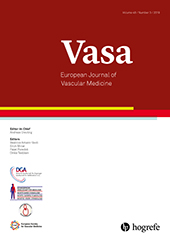Ablation therapy with cyanoacrylate glue and laser for refluxing great saphenous veins – a prospective randomised study
Abstract
Summary:Background: Endovenous cyanoacrylate ablation is a new technique for the treatment of clinically symptomatic venous insufficiency. The results of a prospective comparative study of cyanoacrylate glue versus endovenous laser ablation for the management of incompetent great saphenous veins are presented. Patients and methods: A total of 400 subjects were treated with cyanoacrylate ablation or endovenous laser ablation between April 2014 and April 2016. The preprocedural, procedural, postprocedural, and follow-up data were recorded and compared. Results: There were 208 procedures in cyanoacrylate ablation group (CAA) and 204 in endovenous laser ablation group (EVLA). Operative time was 13 ± 3.4 minutes in the CAA and 31.7 ± 8.8 minutes in the EVLA (< 0.001). All procedures in both groups were successful, and the target vein segments were fully occluded at the end of the procedure. Periprocedural pain was less in the CAA (< 0.001). Enduration, ecchymosis, and paresthesia rates were significantly higher in the EVLA (< 0.001). The mean length of follow-up was 14 months (range 10–16). The 3, 6 and 12 months closure rates were 97.4%, 95.6%, and 94.1% for EVLA and 98.6%, 97.1% and 96.6% for CAA respectively. In both groups, the Venous Clinical Severity Score and Chronic Venous Insufficiency Quality of Life Questionnaire with declined significantly with no difference between groups. Conclusions: Management of incompetent great saphenous veins both endovenous cyanoacrylate ablation and laser ablation results in high occlusion rates. Endovenous cyanoacrylate ablation technique is fast and simple with low periprocedural pain that does not require tumescent anesthesia and compression stockings.
References
1 Management of chronic venous disorders of the lower limbs: Guidelines according to scientific evidence. Int Angiol. 2008;27:1–59.
2 Recurrent varicose veins: sonography-based re-examination of 210 patients 14 years after ligation and saphenous vein stripping. Vasa. 2006;35:21–26.
3 . Endovenous laser therapy and radiofrequency ablation of the great saphenous vein: Analysis of early efficacy and complications. J Vasc Surg. 2005;42:488–93.
4 The care of patients with varicose veins and associated chronic venous diseases: clinical practice guidelines of the Society for Vascular Surgery and the American Venous Forum. J Vasc Surg. 2011;53:2–48.
5 . Randomized clinical trial comparing endovenous laser ablation, radiofrequency ablation, foam sclerotherapy and surgical stripping for great saphenous varicose veins. Br J Surg. 2011;98:1079–87.
6 Radiofrequency Endovenous Closure FAST Versus Laser Ablation for the Treatment of Great Saphenous Vein Reflux: a multicentre, singleblinded, randomized study (RECOVERY Study). J Vasc Interv Radiol. 2009;20:752–59.
7 . The use of cyanoacrylate adhesives in peripheral embolisation. J Vasc Interv Radiol. 2001;12:907–13.
8 . First human use of cyanoacrylate adhesive for treatment of saphenous vein incompetence. J Vasc Surg: Venous and Lymphatic Disorders. 2013;1:174–80.
9 The European multicentre cohort study on cyanoacrylate embolisation of refluxing great saphenous veins. J Vasc Surg: Venous and Lymphatic Disorders. 2015;3:2–7.
10 Randomized trial comparing cyanoacrylate embolisation and radiofrequency ablation for incompetent great saphenous veins (VeClose). J Vasc Surg. 2015;61:985–94.
11 . Thirtysixth-month follow-up of first-in-human use of cyanoacrylate adhesive for treatment of saphenous vein incompetence. J Vasc Surg Venous Lymphat Disord. 2017;5:658–66.
12 . A prospective comparison of a new cyanoacrylate glue and laser ablation for the treatment of venous insufficiency. Phlebology. 2016;31:106–13.
13 N-butyl cyanoacrylate in the treatment of venous insufficiency: the effect of embolisation with ablative polymerisation. Vasa. 2016;45:241–46.
14 . Early-term outcomes for treatment of saphenous vein insufficiency with N-butyl cyanoacrylate: A novel, non-thermal, and nontumescent percutaneous embolization technique. Heart Surg Forum. 2016;19:118–22.
15 Nonthermal, nontumescent endovenous treatment of varicose veins. Ann Vasc Surg. 2016;36:231–35.
16 Mıd-term results ın the treatment of varıcose veıns wıth N-butyl cyanoacrılate. Phlebology. 2017;32:665–69.
17 Ablation of the great saphenous vein with nontumescent n-butyl cyanoacrylate versus endovenous laser therapy. J Vasc Surg: Venous and Lym Dis. 2017;5:210–15.
18 A systematic review and meta-analysis of two novel techniques of nonthermal endovenous ablation of the great saphenous vein. J Vasc Surg Venous Lymphat Disord. 2017;5:880–96.
19 . A retrospective study of a new n-butyl-2-cyanoacrylate glue ablation catheter incorporated with application guiding light for the treatment of venous insufficiency: Twelve-month results. Vascular. 2018;26:547–55.
20 . Comparison of cyanoacrylate closure and radiofrequency ablation for the treatment of incompetent great saphenous veins: 36-Month outcomes of the VeClose randomized controlled trial. Phlebology. 2018;7:268355518810259.
21 . A randomised clinical trial comparing n-butyl cyanoacrylate, radiofrequency ablation and endovenous laser ablation for the treatment of superficial venous ıncompetence: two year follow up results. Eur J Vasc Endovasc Surg. 2018;56:553–60.
22 . Construction and validation of a quality of life questionnaire in chronic lower limb venous insufficiency (CIVIQ). Qual Life Res. 1996;5:539–54.
23 More successful results with less energy in endovenous laser ablation treatment: long-term comparison of bare-tip fiber 980 nm laser and radial-tip fiber 1470 nm laser application. Ann Vasc Surg. 2017;45:166–72.
24 . N-butyl 2-cyanoacrylate substitute for IBCA in interventional neuroradiology: histopathologic and polymerization time studies. AJNR Am J Neuroradiol. 1989;10:777–86.
25 . Bleeding gastric and duodenal varicose veins: endoscopic embolisation using tissue adhesives. Dtsch Med Wochenschr. 1992;117:1274–77.
26 . Histopathological study of vascular changes after intra-arterial and intravenous injection of Nbutyl-2-cyanoacrylate. Chin J Dig Dis. 2006;7:175–79.
27 . Cyanoacrylate adhesive for the closure of truncal veins: 60-day swine model results. Vasc Endovasc Surg. 2011;45:631–35.
28 . Novel vein closure procedure using a proprietary cyanoacrylate adhesive: 30-day swine model results. Phlebology. 2012;27:398–403.
29 . Quantitative assessment of polymerisation-binding mechanics of cyanoacrylates: model development and validation. Am J Neuroradiol. 2002;23:772–78.
30 . Varicose vein therapy and nerve lesions. Vasa. 2017;46:96–100.



